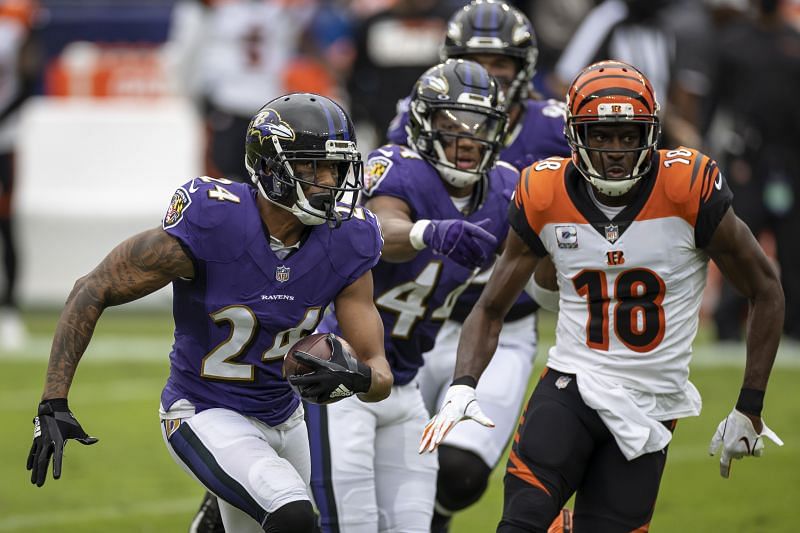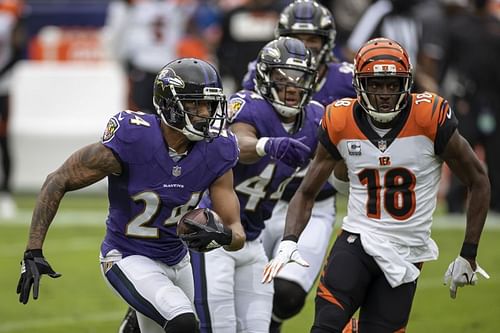
NFL Trade Deadline: Revisiting the Baltimore Ravens' 2019 trade for Marcus Peters

Baltimore Ravens cornerback Marcus Peters looked across the line of scrimmage at the man they call "Mapletron" — Pittsburgh Steelers wide receiver Chase Claypool.
Claypool was crouched, but still towered over Peters, who measures four inches and 45 pounds smaller than the man he was tasked to cover.
On the snap, Claypool beat Peters to the inside on a slant route and caught a quick pass from Pittsburgh quarterback Ben Roethlisberger, but Peters stayed glued to his shoulder. Peters wrapped his arms around Claypool and began to drag him to the ground while prying at the football. As the ball popped loose, Peters scrambled and fell on it.
Once again, Peters did what he was brought in for — what he has done since he joined the Baltimore Ravens ahead of the 2019 NFL trade deadline: Cause turnovers.
After he was traded to the Baltimore Ravens on Oct. 15, 2019, Marcus Peters shined. He showed what an impactful deadline addition can do for a contending team and how a low-risk rental can turn into a franchise staple.
A few weeks removed from the one-year anniversary of the deal, we look back on the Peters trade to see how it has affected both sides:
NFL Trade Deadline: What the Baltimore Ravens gave up for Marcus Peters
The Ravens traded linebacker Kenny Young to the Los Angeles Rams in direct exchange for cornerback Marcus Peters, one-for-one.
Kenny Young was a second-year rotational inside linebacker for the Ravens, filling one of their weakest position groups since the departure of C.J. Mosley. Young started in three games and played in five for the Ravens in 2019 and forced a lone fumble. At the time of the deal, Peters had started six games for the Rams, nabbing two interceptions (one pick-six) and was on pace for a career-low in passes defended. The then-Rams DB was set to head to free agency, in the final year of his deal.
NFL Trade Deadline: How the Marcus Peters trade looks now
Since the 2019 trade deadline, the Baltimore Ravens have gone 14-2 while the Rams have gone 9-7. Although neither team won a playoff game last season, and both have had highs and lows in 2020, there was a clear on-paper winner of the trade.
Peters came in and rejuvenated an already dominant Baltimore Ravens secondary — he made three interceptions and scored two defensive touchdowns for Baltimore and earned himself a three-year, $52 million extension for "playing like a Raven," as coach John Harbaugh says.
L.J. Fort, who was on the scrap heap after being released by the Eagles halfway through 2019, filled in for Young at inside linebacker and flourished. Though ILB was still an area to address heading into the 2020 offseason, the Ravens now start potential Defensive Rookie of the Year Patrick Queen at the position.
On the other side of the trade, Young provided about expected value for the Rams. The now 25-year-old has forced and recovered one fumble in 19 games (three starts) for the Rams, and registered 16 solo tackles. Young, who's Pro Football Focus grade is more than 20 points lower than Peters', still sits atop the depth chart at ILB for the Rams, but splits time and starts with Justin Hollins and Troy Reeder.
Off-field factors (like personality and salary fits) certainly motivated the Rams to flip Peters in 2019, but it would be hard to grade the deal as anything other than a Baltimore Ravens win. Peters stepped into a Baltimore Ravens defense that rostered big-time players and big-time personalities throughout franchise history and fit right in.